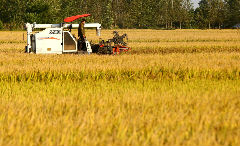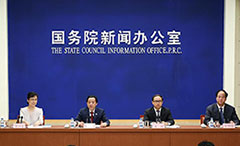China reaping harvest of agricultural R&D
2018-10-22
Xinhua
BEIJING — China is transforming its traditional agriculture sector, using science and technology to drive rural revitalization and modernization.
Delivering a report on the development of China’s agricultural science and technology recently, Tang Huajun, president of the Chinese Academy of Agricultural Sciences (CAAS), said remarkable progress has been made in innovation, which has played an important role in ensuring national food security and increasing farmers’ incomes.
However, production costs remain high while the price of products has reached its “ceiling”, resulting in reduced profits. China is also facing challenges such as limited resources and environmental pollution, and lacks core competitiveness, Tang said.
Scientific and technological innovation is urgently required to facilitate supply-side structural reform, promote environment-friendly development and support the implementation of rural revitalization, Tang said.
The academy has drawn up a five-year plan for developing key technologies in fields such as high-quality crop varieties, automated machines, agricultural products processing, modern food manufacturing, water efficiency, pollution control, agricultural waste recycling, and ecological restoration and protection.
According to the CAAS report, scientific and technological progress contributed to 57.5 percent of China’s agricultural growth in 2017, in comparison with 53.5 percent in 2012.
Chinese researchers have made several breakthrough scientific and technological achievements since 2012, including cultivation and promotion of high-yield rice species and new genetically-modified cotton species that resist insects, as well as the successful development of highly efficient vaccines for the deadly H7N9 bird flu virus, the report said.
With diminishing availability of farm land, fresh water and other resources, science and technology is playing a bigger role in lifting grain yields. China’s grain output has been stable at over 600 million tons for each of the last five years.
The wide application of biotechnology, information technology, materials technology and resource and environmental technology has boosted research in fields such as animal and plant breeding, pest control, processing, storage and transportation, and quality and safety of agricultural products, Tang said.
Chinese scientists have discovered excellent germplasm resources and genes. They have basically completed the genetic mapping and sequencing of rice, wheat, maize, cotton, soybean, millet, tomato, cucumber, cabbage and other major crops.
With the help of genome editing technology, the efficiency of animal breeding has greatly improved. Chinese scientists have accomplished genome sequencing of pigs, cattle, sheep, chickens, ducks and geese.
Tang said the cultivation of genetically modified cotton in China has expanded to more than 450 million mu (30 million hectares).
A large number of agricultural machines and equipment are connecting with China’s Beidou navigation system. China has developed plant factories with intelligent LED illumination technology. Drones are used in spraying pesticides precisely, greatly improving the operational efficiency.
China’s agricultural technology is also benefiting the world.
Avian influenza vaccines produced in China are available in Asia and Africa. China has provided more than 70 hybrid rice species to countries including Indonesia, Pakistan, India and the Philippines. China has demonstrated the cultivation of 68 varieties of super high-yield rice in 18 countries in Asia and Africa, covering a total area of 1.8 million hectares, with an average yield increase of about 20 percent.
China has established an experimental station in Kyrgyzstan to promote high quality cotton varieties and technologies in central Asia.
China and Cuba have cooperated in silk-farming and animal husbandry, greatly promoting the development of Cuba’s silk industry.


